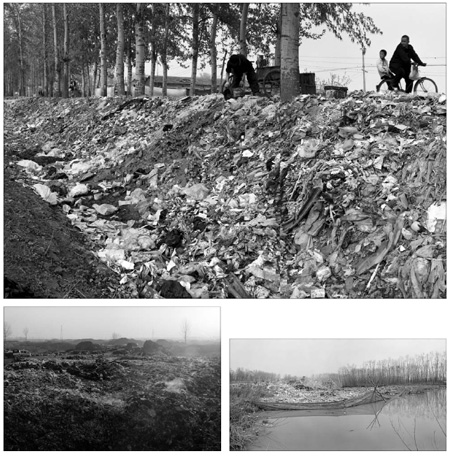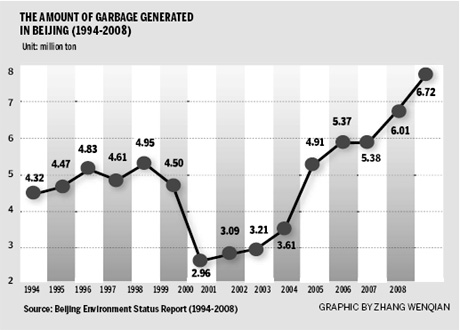Focus
Sorting the waste crisis
By Meng Jing (China Daily)
Updated: 2010-03-15 10:56
 |
Large Medium Small |
|
 Pictures showing the garbage around suburban Beijing (clockwise from the top): Taihu township in Tongzhou district; Shaziying village in Chaoyang district; west of Shahe Reservoir in Changping district. Wang Jiuliang / for China Daily
|
Yang Changjiang is one of the few residents in the city who takes responsibility for his garbage. Ever since the beginning of February, Yang and his high school daughter routinely go to their balcony after meals to clean, sort, weigh and recycle their trash.
Yang's concern about the amount of garbage being generated by the city began in 2009, the year Beijing officials revealed that all the city's 13 landfills would reach their limit by 2015, and the year the government announced its plan to build more waste treatment facilities, incineration plants in particular, as the way to tackle Beijing's garbage crisis. A plan vigorously opposed by residents living near existing or planned waste incineration projects.
So which is worse - a city surrounded by garbage in noxious landfill sites, or the possibly toxic air pollutants emanating from incineration plants?
Meanwhile, the clock is ticking and the garbage is still piling up.
According to statistics from the Beijing Municipal Commission of City Administration, the city produced 6.72 million tons of domestic garbage in 2008 and the amount is growing by 8 percent a year. Although, to look on the bright side, last year witnessed a 0.5 percent fall in garbage generation compared with 2008. But, whichever way you look at it garbage is a growing problem, and one that is threatening to get out of control.
However, from Yang's perspective, the solution is simple - people need to take responsibility for their garbage. He believes sorting and reducing garbage is the key to its treatment whether incinerators or landfill are the final destination.

Kitchen refuse is one of the biggest problems for garbage treatment all over the world. Even though there are great resources for composting organic kitchen waste, it is almost impossible to sort by machine once it gets mixed with other garbage. Sorting at source would make it viable to compost.
After a month-long experiment, Yang announced his preliminary results in early March at a meeting of the Friends of Nature, an NGO based in Beijing.
After dividing his domestic garbage into six categories - kitchen garbage, plastics, papers, china and glass, electronics and metal, and fabrics - he found that his family produced 107.36 kg of garbage in February, out of which 72 percent could be recycled.
He also spent nearly 1,000 yuan ($146) on a family-use garbage treatment machine that can dry 23.1 kg of kitchen garbage into 7.5 kg, so that it can be recycled as organic fertilizer. He firmly believes that garbage sorting has huge potential.
"I threw my garbage into public containers just once last month. Before, I used to have to take it out every two or three days. Even from the perspective of the fuel used in garbage transportation, if all the residents in Beijing can reduce their garbage, it will be a big success," he said.
Yang does the sums. Beijing currently produces around 18,400 tons garbage per day. That is 6.72 million tons a year, of which 55.86 percent is kitchen waste. After being dried, the city can turn 3.82 million tons of its leftovers into 1.15 million tons of organic fertilizer.

If the future of garbage sorting is as promising as Yang describes, why are so few actually doing it?
"Most people haven't actually realized the crisis we are facing," said Wen Hengfeng, an environmentalist from the Global Village of Beijing, which is the first NGO promoting garbage sorting in the capital. "For those who do know the urgency of the situation, they still need a little push to make the move," she said.
Wen, who joined the Global Village of Beijing in 2007, often spends her weekends informing people of the benefits of garbage sorting and organizing visits to landfill sites so that people can see them firsthand.
| ||||
But according to Wen, most of the time, her activities only attract the elderly as they have time. "Forming a new habit is a long-term project. Getting more people to commit themselves to garbage sorting is a problem faced by all the NGOs," she said.
However, for Huang Xiaoshan, a lawyer who recently returned from a 10-day field trip to Japan and Macao along with government officials in search of solutions to the garbage issue, the problem can be easily solved.
"Make it law," said Huang, "Chinese people respect laws and regulations. The reason why garbage sorting is still in trail in Beijing after so many years is the lack of law."
Huang was the only non-government representative on the trip. He became active in seeking solutions to the garbage problem when he discovered there was a proposal to build a garbage incinerator near his community in Changping district last year.









